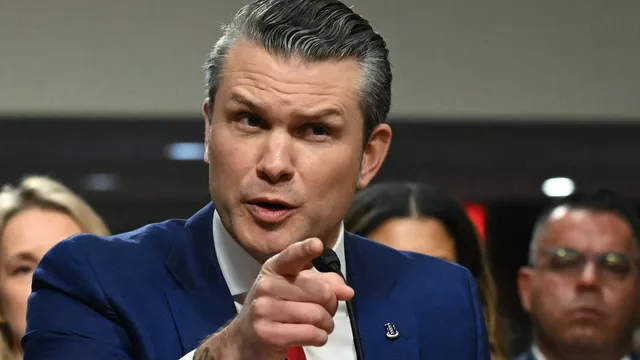
Pete Hegseth snubs Ukraine war meeting, attends virtually instead
2025-04-11 14:10- Defense Secretary Pete Hegseth did not attend the 27th meeting of the Ukraine Defense Contact Group in Brussels.
- U.K. Defense Secretary John Healey committed approximately $590 million in military aid to Ukraine.
- Hegseth's absence marked a significant shift in U.S. involvement in Ukraine, raising questions about future military support.
Express your sentiment!
Insights
In Brussels, Belgium, on April 11, 2025, leaders from around 50 nations gathered for the 27th meeting of the Ukraine Defense Contact Group. This meeting was crucial for planning military aid to Ukraine amid ongoing conflict with Russia. However, U.S. Defense Secretary Pete Hegseth made the decision to skip the meeting and instead participated virtually. This marked a significant moment as it was the first time in the assembly's three-year history that a U.S. defense secretary was absent from an in-person meeting. The decision by Hegseth to dial in from the U.S. came on the heels of a notable shift in the Trump administration's approach towards Ukraine, raising questions about America’s commitment to supporting the war-torn nation. British Defense Secretary John Healey represented the U.K. at the meeting, where he pledged significant military support worth approximately $590 million to bolster Ukraine's defenses against Russian aggression. The U.S. maintains that it remains open to providing military assistance, but Ukrainian President Volodymyr Zelensky has stated that Ukraine is willing to pay for specific arms, including essential air defense systems. Zelensky emphasized that Ukraine is prepared to invest between $30 billion and $50 billion in defense equipment, highlighting his country's ongoing struggle and determination for sovereignty. Meanwhile, during the time Hegseth opted out, tensions persisted as evidenced by ongoing military actions from Russia. Leaders at the meeting stressed the importance of continued support to ensure Ukraine is armed adequately to withstand the conflict. Germany, for example, committed to providing 11 billion pounds' worth of military aid, while the U.K. outlined its anticipated spending on military assistance for 2025. U.S. officials indicated that Ukraine relies heavily on American support for critical military capabilities, such as advanced anti-aircraft systems and intelligence sharing. High-ranking U.S. military officials acknowledged the disparity in military support between Europe and the U.S., urging European nations to step up their contributions while acknowledging the essential role the U.S. plays in Ukraine’s overall defense strategy. In a broader context, the meeting reflects ideological divisions among Western nations regarding their levels of engagement and commitment to Ukraine, especially with the Trump administration's evolving strategy towards Russia. As the war continues with ongoing confrontations and territory struggles, the effectiveness of these international efforts remains to be seen.
Contexts
The Biden administration's military aid to Ukraine has been a significant aspect of U.S. foreign policy since the onset of the Russo-Ukrainian conflict. Following Russia's annexation of Crimea in 2014 and the subsequent conflict in Eastern Ukraine, the U.S. has steadily increased its support for Ukraine, with a notable escalation occurring after the full-scale invasion of Ukraine by Russian forces in February 2022. This military assistance has primarily aimed at enhancing Ukraine's defensive capabilities, stabilizing the region, and reinforcing NATO's eastern flank in response to perceived threats from Russia. Through various initiatives, the U.S. has committed billions in military support, including advanced weaponry, training, and intelligence-sharing to bolster Ukraine's military infrastructure and effectiveness on the battlefield. The Biden administration has also worked closely with NATO allies to ensure a coordinated response, facilitating additional support from other nations and reinforcing alliances in the face of aggression. The assistance provided includes a variety of equipment and operational resources. Key provisions have included anti-tank systems like Javelins, air defense systems such as Stingers, artillery systems to conduct offensive operations, and various types of ammunition. Notably, the U.S. has also included training programs for Ukrainian forces to operate advanced weaponry, which has contributed significantly to their operational readiness. These measures have not only improved the capabilities of the Ukrainian armed forces but have also aimed to project U.S. commitment to regional security and the principles of sovereignty and territorial integrity. Furthermore, the military aid has targeted the necessity for Ukraine to sustain prolonged military engagements, implying the U.S. commitment to continuous support as the conflict evolves. In addition to military supplies, the Biden administration has additionally focused on the strategic narrative surrounding U.S. support for Ukraine. The administration has emphasized its commitment to supporting democracy and countering authoritarianism, framing U.S. assistance in Ukraine as part of a larger struggle for global democratic values. This narrative serves to rally domestic and international support for continued aid and signals to both adversaries and allies the seriousness of U.S. intentions. The administration has also advocated for financial and humanitarian assistance alongside military aid, acknowledging the multifaceted nature of this conflict and the human cost involved. As the conflict continues to develop, the Biden administration faces ongoing challenges in maintaining bipartisan support for military aid in a fluctuating political environment. Public opinion on foreign aid can be variable, and policymakers need to navigate complex dynamics around national security, budgetary pressures, and geopolitical strategies. The continued U.S. military aid to Ukraine not only affects the immediate conflict but also has longer-lasting implications for U.S.-Russia relations and the security architecture in Europe. As of now, the Biden administration remains committed to supporting Ukraine and adapting its military aid in line with the evolving nature of the conflict, ensuring that both Ukrainian forces and Western alliances remain robust in the face of ongoing Russian aggression.